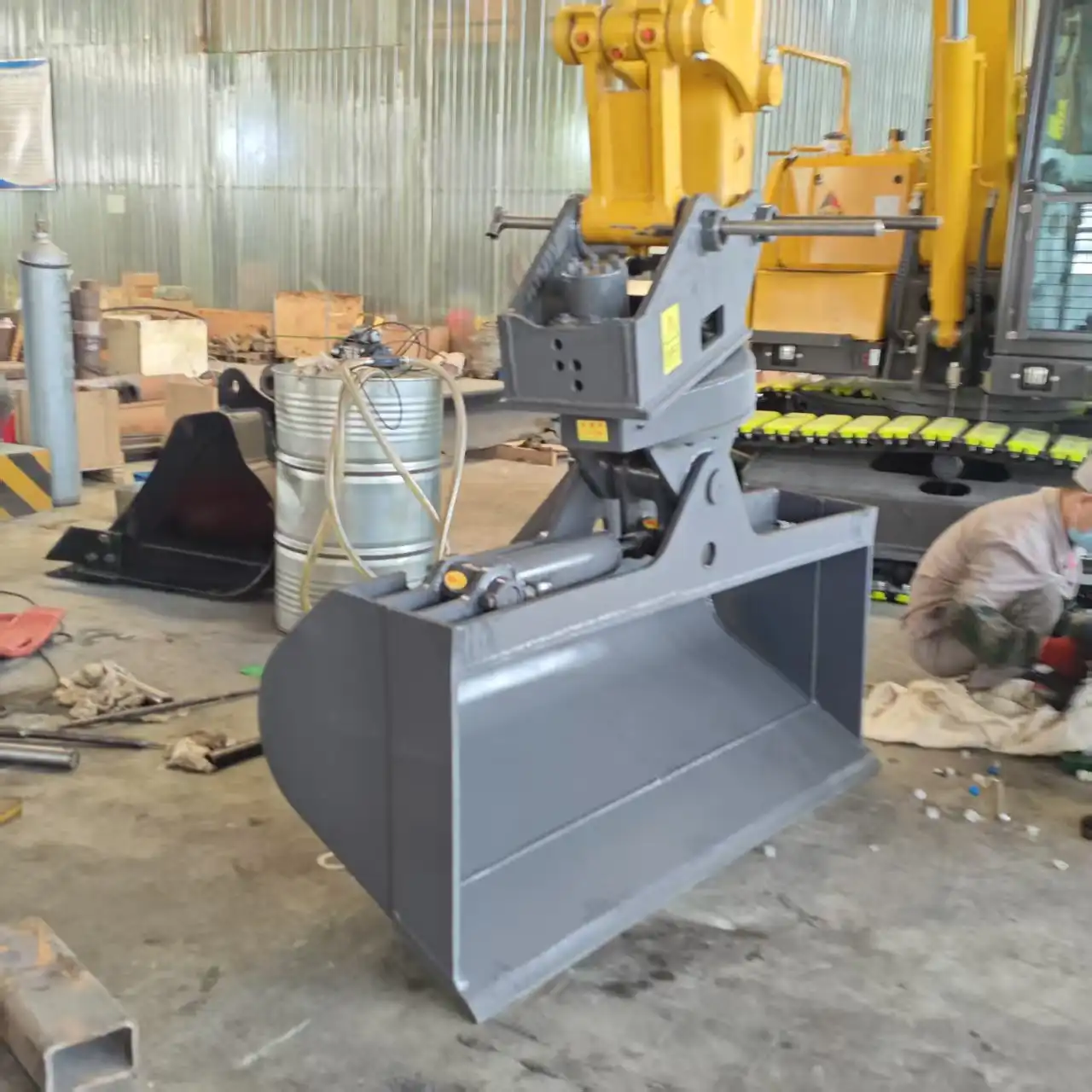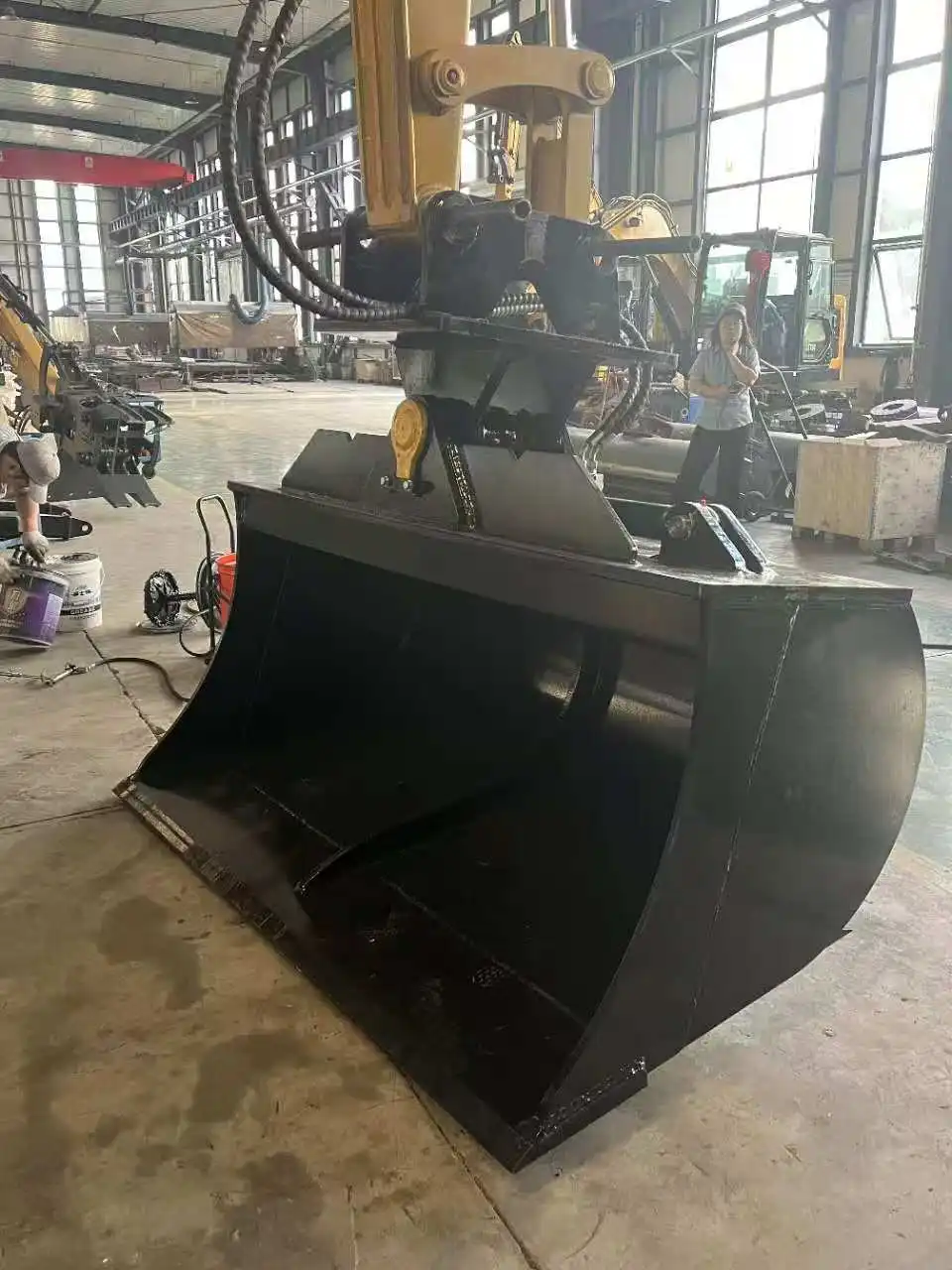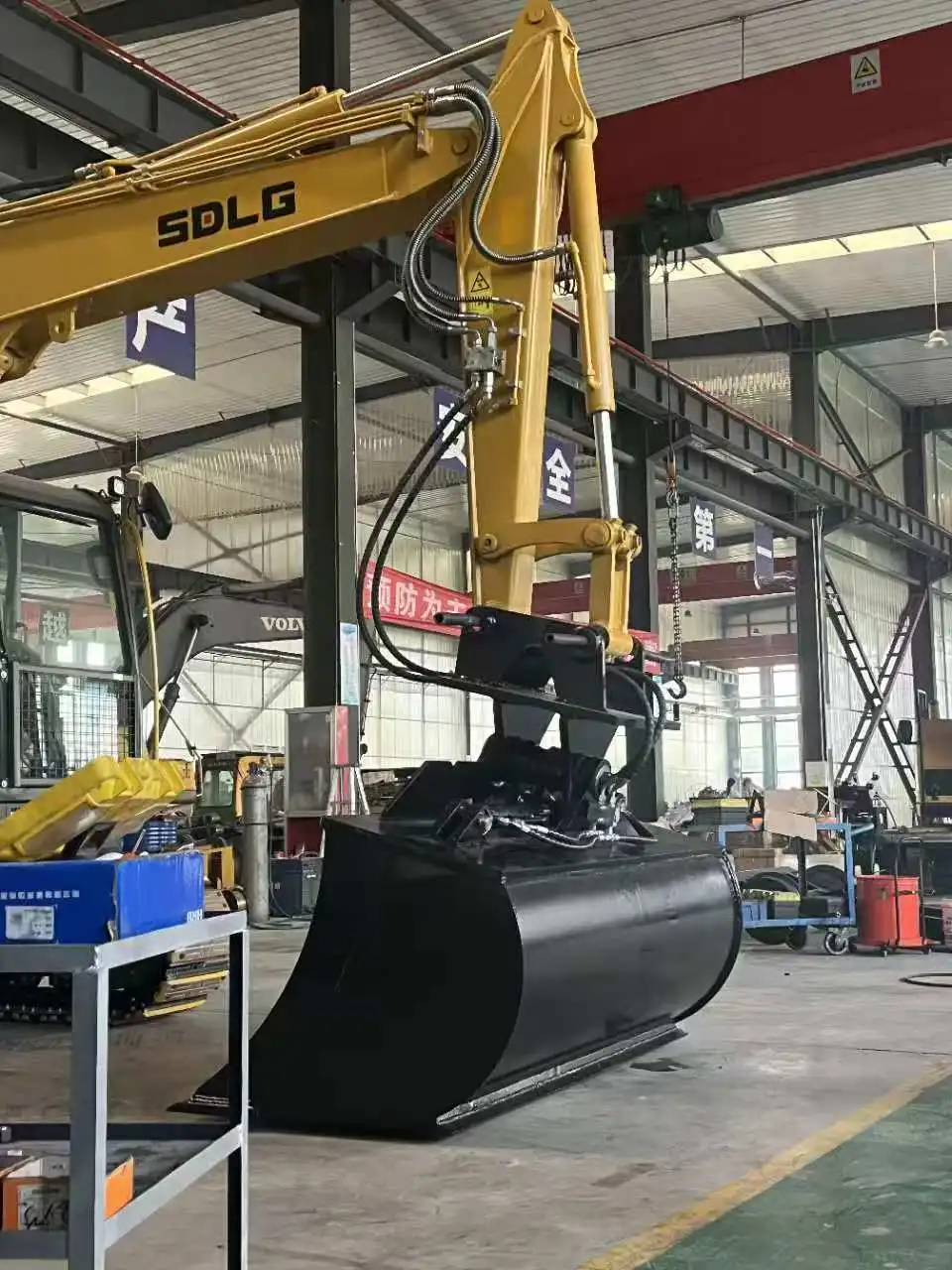Tilt Bucket For 13 Ton Excavator
Are you struggling with precision excavation in tight spaces? Finding it challenging to maintain efficiency on railway construction projects? A degree rotating hydraulic tilt ditching bucket might be exactly what your 13-ton excavator needs to transform its capabilities. These specialized attachments are revolutionizing how construction and railway maintenance professionals approach complex excavation tasks by offering unprecedented flexibility and control.
Unlike standard buckets that limit your range of motion, a tilt bucket equipped with rotation capabilities enables operators to work at various angles without repositioning the entire machine. This single attachment can drastically reduce project timelines while improving accuracy in critical applications like railway maintenance, trench digging, and precision grading. With 360-degree rotation and 45-degree tilt capabilities, these versatile attachments are changing the game for medium-sized excavator operations.
Key Considerations for 13-Ton Excavators

Matching Bucket to Machine Size
Selecting the appropriate tilt bucket for your 13-ton excavator requires careful consideration of compatibility factors. Not all attachments are created equal, and using improperly sized equipment can lead to performance issues or even damage to your valuable machinery.
The sweet spot for medium-sized excavators in the 13-ton range typically involves tilt buckets with capacities between 0.3-0.5 cubic meters. These dimensions ensure optimal balance between digging power and maneuverability without overtaxing the hydraulic system. When evaluating options, pay special attention to the connection points and hydraulic requirements to ensure seamless integration with your specific excavator model.
Railway maintenance crews particularly benefit from specialized degree hydraulic tilt ditching buckets with a width of approximately 1600mm, which provides sufficient coverage for standard railway beds while maintaining the precision needed for delicate work around tracks and signals. Remember that undersized buckets may extend project timelines unnecessarily, while oversized attachments can compromise stability and precision.
Hydraulic System Compatibility
The heart of any degree rotating hydraulic tilt ditching bucket is its sophisticated hydraulic system. Before investing in this attachment, verify that your 13-ton excavator can supply sufficient hydraulic flow and pressure to power both the rotation and tilt functions effectively.
Most modern 13-ton excavators feature auxiliary hydraulic circuits that can accommodate these specialized attachments, but older models might require modifications or upgrades. The ideal setup includes dedicated lines for both the rotating mechanism and the tilting function, allowing for simultaneous operation and more intuitive control. Some advanced systems even incorporate proportional control valves that enable operators to adjust movement speed based on the sensitivity of the task.
Professional installation is strongly recommended to ensure proper hydraulic line routing and pressure settings. Improper setup can result in jerky movements, reduced control precision, or even catastrophic hydraulic system failures. Consult with hydraulic specialists familiar with excavator attachments to optimize your system for maximum performance and longevity.
Material Quality and Durability
The operating environment for railway construction and maintenance equipment is notoriously harsh. Ballast stones, metal tracks, and constant exposure to the elements can quickly deteriorate substandard attachments. When selecting a degree rotating hydraulic tilt ditching bucket for your 13-ton excavator, prioritize construction materials and build quality.
Premium buckets utilize high-strength Q460 steel for the main structure, reinforced with WH60C components at critical wear points. This combination offers exceptional resistance to impacts and abrasion while maintaining a reasonable weight. The rotation mechanism should feature sealed bearings and protected hydraulic components to prevent contamination from dust and debris common in railway environments.
Look for buckets with replaceable wear edges and reinforced corners, as these areas experience the most intense wear during operation. Quality manufacturers offer wear packages designed specifically for railway applications, with hardened steel inserts strategically placed to extend service life in these demanding conditions.
Bucket Capacity & Weight

Optimizing Productivity with Appropriate Capacity
The capacity of your tilt bucket directly impacts productivity, fuel efficiency, and overall equipment effectiveness. For 13-ton excavators, a degree rotating hydraulic tilt ditching bucket with approximately 0.4 cubic meter capacity represents an ideal balance for most railway construction and maintenance applications.
This capacity allows operators to move sufficient material in each cycle without overloading the machine's hydraulic system or compromising stability during rotation and tilting operations. When working with railway ballast or shoulder formation, this size enables precise material placement while maintaining efficient work rates. Operators report that this capacity sweet spot reduces fuel consumption by up to 15% compared to repeatedly moving smaller loads or struggling with oversized buckets.
For specialized applications like fine grading or working in confined spaces alongside active tracks, some operators prefer slightly smaller capacities around 0.35 cubic meters, which provide enhanced control and visibility. Conversely, for bulk earthmoving phases of railway construction, capacities up to 0.45 cubic meters may be appropriate if your 13-ton excavator has sufficient hydraulic capacity and counterweighting.
Customization Options and Adaptability
The most effective degree rotating hydraulic tilt ditching buckets offer customization options to address specific operational requirements. For railway maintenance applications, buckets with both plane and grid-type bottoms provide versatility across different tasks.
Plane-bottom configurations excel in precision grading and finishing operations, creating smooth surfaces with minimal material disturbance. These are ideal for final shaping of railway embankments and drainage systems. Grid-bottom variants allow material to drain while retaining larger aggregate, perfect for working with ballast and other drainage-critical applications.
The 35-degree tilt capability proves optimal for shoulder forming operations along railway beds, allowing operators to achieve precise angles without repositioning the entire machine. This feature alone can reduce completion time for railway maintenance projects by up to 30% compared to standard fixed buckets. The ability to customize your attachment based on specific project requirements enhances overall equipment effectiveness and return on investment.
Installation & Maintenance

Professional Installation Procedures
Proper installation of a degree rotating hydraulic tilt ditching bucket is crucial for both performance and safety. While experienced equipment technicians might handle basic attachment swaps, the complexity of rotating tilt buckets typically warrants professional installation.
The process begins with verifying compatibility between the excavator's quick coupler system and the attachment mounting points. Many modern buckets feature universal mounting patterns, but adapter plates may be required for certain configurations. Next, hydraulic connections must be properly routed and secured to prevent pinching, rubbing, or exposure to damage during operation.
Calibration of hydraulic pressures is perhaps the most critical step in the installation process. Excessive pressure can damage seals and valves within the rotation and tilt mechanisms, while insufficient pressure results in sluggish performance and reduced control. Professional installers use specialized testing equipment to set optimal operating pressures based on both the excavator's capabilities and the attachment's requirements.
Following installation, a comprehensive testing protocol should verify smooth operation throughout the full range of motion under various load conditions. This identifies any potential issues before the equipment enters service, preventing costly downtime and potential safety hazards.
Regular Maintenance Schedules
The sophisticated nature of degree rotating hydraulic tilt ditching buckets demands a disciplined maintenance regimen to ensure reliable operation and maximum service life. Developing and following a structured maintenance schedule pays dividends through reduced downtime and repair costs.
Daily inspections should include visual checks of hydraulic components for leaks, inspection of the rotation bearing for debris accumulation, and verification that all grease points show evidence of adequate lubrication. Operators should report any unusual sounds, vibrations, or changes in performance immediately, as these often indicate developing issues.
Weekly maintenance typically involves more thorough greasing of all rotation and pivot points, torque checking of critical fasteners that may loosen during operation, and inspection of wear edges for signs of excessive deterioration. Monthly service should include hydraulic filter inspection or replacement, more detailed structural inspection, and verification of rotation bearing clearances.
Seasonal maintenance should address environmental concerns, such as preparing for winter operations by checking hydraulic fluid viscosity and replacing with cold-weather compatible options if necessary. Equipment working in extremely dusty railway construction environments may require more frequent air filter changes and additional protective measures for hydraulic components.
FAQ
①What makes a tilt bucket better than a standard bucket for railway maintenance?
A degree rotating hydraulic tilt ditching bucket offers 360-degree rotation and 45-degree tilt capabilities that standard buckets lack. This flexibility allows operators to precisely shape railway shoulders, work at angles without repositioning the excavator, and significantly reduce project completion times. The specialized design also enables backfilling railway slag and performing shoulder forming operations more efficiently than conventional attachments.
②How does bucket capacity affect excavator performance?
For 13-ton excavators, the optimal bucket capacity is approximately 0.4 cubic meters. This size balances productive material movement with machine stability and hydraulic system capabilities. Oversized buckets can strain hydraulic systems and compromise stability, while undersized options reduce efficiency. The right capacity ensures optimal fuel efficiency and productivity for railway construction and maintenance operations.
③Can tilt buckets be used in frozen ground conditions?
Yes, but with modifications. Quality degree rotating hydraulic tilt ditching buckets can handle frozen ground when equipped with appropriate wear packages and operated within design parameters. Some operators add specialized teeth or ripper attachments for extreme conditions. Cold-weather hydraulic fluid may be necessary to maintain proper operation in low temperatures, and warm-up procedures become more important to prevent damage to seals and hydraulic components.
About Tiannuo
The hydraulic tilt ditching bucket represents a significant advancement in excavator attachment technology, particularly for 13-ton machines engaged in railway construction and maintenance. With its 360-degree rotation capability, 45-degree tilt function, and specialized design features, this versatile attachment transforms an ordinary excavator into a precision grading and forming tool capable of tackling the most demanding railway applications.
By selecting the appropriate capacity, ensuring proper hydraulic compatibility, and maintaining a disciplined service schedule, operators can maximize the productivity and service life of these sophisticated attachments. The investment in quality components and proper installation pays dividends through increased efficiency, reduced project timelines, and enhanced capability across a wide range of specialized applications.
For railway construction and maintenance professionals seeking to elevate their excavator capabilities, the degree rotating hydraulic tilt ditching bucket deserves serious consideration. To learn more about these specialized attachments and find the perfect solution for your 13-ton excavator, contact our team of Tiannuo experts at boom@stnd-machinery.com.
References

Journal of Railway Construction and Maintenance Equipment, "Advancements in Excavator Attachments for Railway Applications," Volume 28, Issue 3, 2023.
Smith, J., "Hydraulic Attachment Systems for Medium-Sized Excavators," Construction Equipment Technology Review, 2024.
International Association of Railway Maintenance Contractors, "Best Practices for Ballast Management and Shoulder Formation," Technical Guide 7-B, 2023.
Williams, R., "Material Selection for High-Wear Excavator Attachments," Engineering Materials Quarterly, Volume 15, Issue 2, 2024.
Construction Equipment Manufacturers Association, "Hydraulic System Compatibility Standards for Excavator Attachments," Technical Bulletin 2024-03, 2024.
About Author: Arm
Arm is a leading expert in the field of specialized construction and railway maintenance equipment, working at Tiannuo Company.

